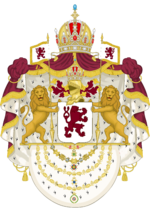The Estmerish term Weranians has historically referred to the Weranic-speaking population of the Rudolphine Confederation since the early Middle Ages. Ever since the outbreak of the Reformation within the Rudolphine Confederation, Weranian society has been characterized by a Catholic-Amendist divide. Weranians due to their long history of internal division have extremely strong regional identities often with unique dialects.
Men in Werania tend to gravitate towards the fashions enjoyed by most of the East, though they tend to adapt more slowly to global fashions and may reject some of the more unruly designs used in more liberal countries. There is an observable urban-rural divide, with urban Weranians dressing less formally and using brighter colours while the rural folk tend towards more conservative outfits, and have a preference for plainer colours.
The flat cap has remained a very popular piece of headgear for Weranic men since it was introduced in the 14th century as a way of differentiating commoners from the nobility. Though these restrictions gradually ended in the 17th century, it remained a favourite and was even adopted by the nobility during outdoor leisure pursuits. Wearage of it has decreased in modern times, especially among urban populations, but it has retained great popularity amongst the rural population and is a potent symbol of 'Merry Werania'
Women in Werania have adopted many fashions in the East, though they have adapted these fashions towards the more conservative views and expectations of women in Werania. There is an urban-rural divide in clothing, much the same as men, though working urban women and working rural women have both adopted previously male oriented clothes, such as trousers and blazers, for practical and legal reasons.
It has been traditional for women in Werania to cover their hair for thousands of years, though with the exception of rules regarding dress for church, there have been little to no legal requirements for the wearing of headscarfs. It has remained popular amongst women in Werania, despite discouragement during the Confederacy, and surveys suggest that around 15% wear it on a daily basis, while 35% wear it several times a week, and 25% wear it often, depending on what else they are wearing. They come in a great deal of designs and colours, with some denoting the wearer as a member of a particular church, or come from a particular region.
Tracht refers to traditional garments in Weranic-speaking countries. Although the word is most often associated with Bolisian garments, many other peoples of Werania have them. The two most well-known are the lederhosen and drindl, which also come in regional variations. Other than these, there are a great many folk costumes enjoyed in the various states and regions of Werania, and national dresses popular in other Weranic-speaking countries, which fall under the umbrella of tracht.
The traditional clothes of Werania are based upon the ideals of peasantry based upon notions created by the outbreak of Romantic Nationalism across Euclea in the 18th century. Such costumes are rarely worn in the modern day, except for certain festivals like Octoberfest.
The Dirndl is the name of a traditional feminine dress worn in Werania. It is based on the traditional clothing of Varsian peasants, but soon became popular all over Werania. The dirndl consists of a bodice, puff sleeved blouse, full skirt and apron. While appearing to be simple and plain, a properly made modern dirndl may be quite expensive as it is tailored and sometimes cut from costly hand-printed or silk fabrics. Different styles are worn in different regions,but globally they are now more of a universally generalized and mass discharged cultural pastiche.
The Lederhosen are breeches made of leather; they may be either short or knee-length. The longer ones are generally called Bundhosen or Kniebundhosen. Once common workwear across Werania, they are now considered a folk costume associated particularly with Bolisia in Werania and the Eastern states of Vredlandia. They are often combined with a blazer, stockings and a classic white or checked shirt.
